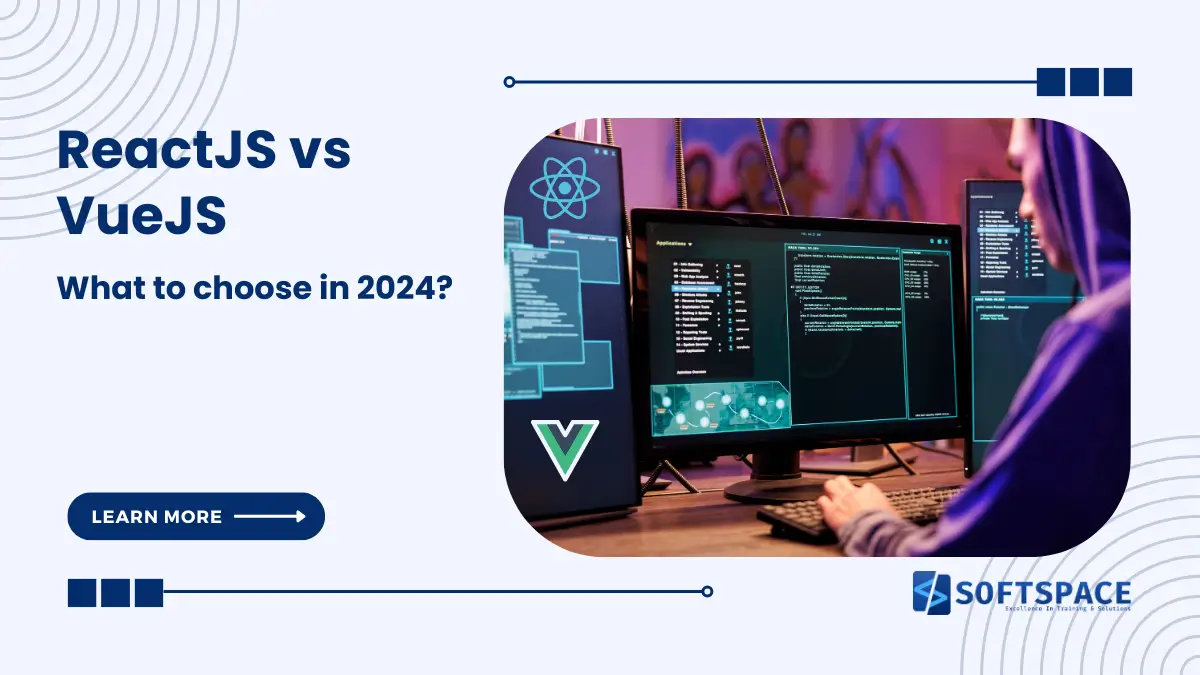In the rapidly evolving world of web development, choosing the right JavaScript framework can significantly impact your project’s success. Two of the most popular frameworks today are ReactJS and VueJS. Both have their strengths and weaknesses and selecting the right one for your needs can be challenging. This comprehensive guide will compare ReactJS and VueJS, helping you make an informed decision in 2024.
Table of Contents
ReactJS vs VueJS
| Aspect | ReactJS | VueJS |
|---|---|---|
| Learning Curve | Moderate, with concepts like JSX requiring understanding. | Gentle, designed for easy adoption and straightforward syntax. |
| Data Binding | One-way data binding, making the application more predictable. | Two-way data binding, simplifying state management in forms. |
| Community and Support | Larger and more active community, strong backing from Facebook. | Strong but smaller community, excellent support from the core team. |
| Ecosystem and Tools | Extensive ecosystem with numerous libraries and tools, including React Native for mobile development. | Robust but smaller ecosystem, with powerful tools like Vue CLI, Vue Router, and Vuex. |
| Scalability | Highly scalable, suitable for large-scale applications with modular components. | Scalable for small to medium-sized projects, can handle larger applications with proper architecture. |
Introduction to ReactJS
ReactJS, developed by Facebook, is a powerful JavaScript library for building user interfaces. Introduced in 2013, ReactJS has gained immense popularity due to its component-based architecture, which allows developers to build complex UIs from small, reusable pieces of code.
Key Features of ReactJS
- Virtual DOM: React uses a virtual DOM to improve performance. Instead of updating the real DOM directly, React makes changes to a virtual DOM first and then updates the real DOM, resulting in faster rendering.
- Component-Based Architecture: React’s architecture allows developers to break down a UI into smaller components, making the code more manageable and reusable.
- One-Way Data Binding: React uses one-way data binding, meaning data flows in one direction, making the application more predictable and easier to debug.
- Strong Community Support: With a vast ecosystem and a large community, finding resources and support for React development is relatively easy.
Introduction to VueJS
VueJS, created by Evan You in 2014, is another popular JavaScript framework. VueJS is known for its simplicity and ease of integration, making it a favourite among developers who want to quickly build dynamic UIs without the complexity of a more extensive framework.
Key Features of VueJS
- Reactivity System: Vue’s reactivity system automatically tracks dependencies, ensuring the UI stays in sync with the underlying data.
- Component-Based Architecture: Like React, Vue also uses a component-based architecture, making the code modular and reusable.
- Two-Way Data Binding: Vue supports two-way data binding, making it easier to handle form input and state management.
- Comprehensive Documentation: Vue’s documentation is extensive and well-organized, making it easier for developers to get started and find answers to their questions.
Performance Comparison
Performance is a critical factor when choosing a JavaScript framework. Both ReactJS and VueJS are known for their high performance, but there are some differences.
ReactJS Performance
ReactJS’s performance is boosted by its virtual DOM, which minimizes direct manipulation of the real DOM. This results in faster updates and rendering, especially in complex applications. Additionally, React’s efficient diffing algorithm ensures that only the necessary parts of the DOM are updated.
VueJS Performance
VueJS also offers excellent performance, thanks to its optimized reactivity system. Vue’s virtual DOM implementation is lightweight and efficient, making it suitable for both small and large applications. In many benchmarks, VueJS performs on par with or even better than ReactJS, particularly in scenarios with dynamic and interactive content.
Ease of Learning and Use
The learning curve is an important consideration, especially for new developers or teams adopting a new framework.
ReactJS Learning Curve
ReactJS has a moderate learning curve. While the concept of JSX (a syntax extension that allows HTML within JavaScript) can be initially confusing, once understood, it makes the development process more intuitive. However, integrating React with other tools and libraries can sometimes add complexity.
VueJS Learning Curve
VueJS is often praised for its gentle learning curve. The framework is designed to be incrementally adoptable, meaning developers can start with just the view layer and gradually integrate more features as needed. Vue’s syntax and structure are straightforward, making it easier for beginners to pick up quickly.
Flexibility and Ecosystem
A framework’s flexibility and the strength of its ecosystem can significantly impact its adoption and usability in various projects.
ReactJS Flexibility and Ecosystem
ReactJS is highly flexible and can be used for a wide range of applications, from simple websites to complex web apps. The React ecosystem is vast, with numerous libraries and tools available to extend its functionality. React Native, for example, allows developers to build mobile applications using React.
VueJS Flexibility and Ecosystem
VueJS is also very flexible and can be integrated into existing projects with ease. The Vue ecosystem, while not as extensive as React’s, is still robust and growing. Vue CLI, Vue Router, and Vuex are powerful tools that simplify development and state management.
Community and Support
Community support is crucial for the ongoing success and improvement of any framework.
ReactJS Community and Support
ReactJS has a large and active community. There are numerous tutorials, forums, and resources available for developers. The strong backing from Facebook and regular updates ensure that React remains a top choice for developers.
VueJS Community and Support
VueJS also boasts a strong community, though smaller than React’s. The support from the community and the core team is excellent, with frequent updates and a wealth of resources available. Vue’s open-source nature and contributions from developers worldwide make it a thriving framework.
Integration with Existing Projects
The ability to integrate with existing projects can save significant time and effort.
ReactJS Integration
ReactJS is highly flexible and can be integrated into existing projects without significant changes to the codebase. Its modular nature allows developers to introduce React components incrementally.
VueJS Integration
VueJS is designed to be incrementally adoptable, making it easy to integrate with existing projects. Its flexibility allows developers to use as much or as little of the framework as needed, making it an excellent choice for projects that require gradual migration.
State Management
State management is a critical aspect of any dynamic web application.
ReactJS State Management
ReactJS offers several state management options. The built-in state and context APIs are suitable for simple state management. For more complex applications, libraries like Redux or MobX can be used to manage the state effectively.
VueJS State Management
VueJS has a built-in state management solution called Vuex, which is specifically designed for managing the state in Vue applications. Vuex provides a centralized store for all components, making state management more predictable and easier to debug.
Scalability
Scalability is essential for applications that may grow in complexity over time.
ReactJS Scalability
ReactJS is highly scalable, thanks to its modular architecture. Large-scale applications can be built by composing small, reusable components. React’s ecosystem also includes tools and libraries that support scalability, such as React Router for routing and Redux for state management.
VueJS Scalability
VueJS is also scalable, though it is often seen as more suitable for smaller to medium-sized applications. However, with proper architecture and the use of tools like Vue Router and Vuex, VueJS can handle large-scale applications effectively.
Popularity of ReactJS vs VueJS
ReactJS and VueJS are two of the most popular JavaScript frameworks used for building modern web applications, but they have different levels of popularity and adoption in the industry.
ReactJS
ReactJS, developed by Facebook, has been a dominant player in the web development landscape since its release in 2013. Its popularity is driven by several key factors:
- Corporate Backing: Strong support from Facebook ensures continuous development, regular updates, and extensive resources.
- Large Ecosystem: A vast ecosystem of libraries, tools, and extensions, including React Native for mobile app development.
- Community Support: A large, active community with numerous tutorials, forums, and conferences.
- Widespread Adoption: Used by many large companies such as Facebook, Instagram, Airbnb, and Netflix, making it a highly sought-after skill in the job market.
Due to these factors, ReactJS often appears at the top of surveys and polls regarding the most popular JavaScript frameworks, and its job market remains robust and expansive.
VueJS
VueJS, created by Evan You and released in 2014, has rapidly gained popularity, especially among developers looking for a more straightforward and flexible framework:
- Ease of Learning: Vue’s gentle learning curve and well-organized documentation make it accessible to beginners.
- Incremental Adoption: Designed to be incrementally adoptable, meaning developers can use as much or as little of the framework as needed.
- Community and Contributions: A strong and growing community with significant contributions from developers worldwide.
- Corporate Usage: Adopted by companies like Alibaba, Xiaomi, and Grammarly, indicating its growing influence and acceptance.
While VueJS does not have the same level of corporate backing as React, its simplicity and flexibility have won over many developers, leading to a steady increase in its adoption and popularity.
Job Market
The popularity of a framework can impact the availability of developers and job opportunities.
ReactJS Popularity and Job Market
ReactJS is one of the most popular JavaScript frameworks, with widespread adoption in the industry. This popularity translates to a strong job market, with numerous opportunities for React developers. Companies like Facebook, Instagram, and Airbnb use React, further boosting its credibility and demand.
VueJS Popularity and Job Market
VueJS has gained significant traction in recent years and is becoming increasingly popular among developers. While the job market for Vue developers is not as large as for React developers, it is growing steadily. Companies like Alibaba, Xiaomi, and Grammarly use Vue, indicating its rising prominence.
Salary: ReactJs vs VueJS
Conclusion
In 2024, both ReactJS and VueJS remain strong contenders for building modern web applications. ReactJS offers a robust ecosystem, scalability, and strong community support, making it a top choice for large-scale applications and teams seeking flexibility. VueJS, on the other hand, provides a gentle learning curve, ease of integration, and a straightforward approach, making it ideal for smaller to medium-sized projects and developers seeking simplicity.
Ultimately, the choice between ReactJS and VueJS will depend on your specific project requirements, team expertise, and long-term goals. By carefully considering the factors discussed in this article, you can make an informed decision that aligns with your development needs and sets your project up for success in 2024 and beyond.

13+ Yrs Experienced Career Counsellor & Skill Development Trainer | Educator | Digital & Content Strategist. Helping freshers and graduates make sound career choices through practical consultation. Guest faculty and Digital Marketing trainer working on building a skill development brand in Softspace Solutions. A passionate writer in core technical topics related to career growth.

